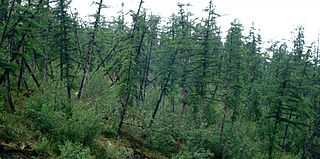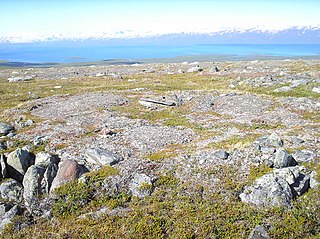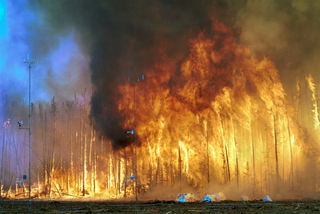Related Research Articles

In physical geography, tundra is a type of biome where the tree growth is hindered by low temperatures and short growing seasons. The term tundra comes through Russian тундра from the Kildin Sámi word тӯндар meaning "uplands", "treeless mountain tract". There are three regions and associated types of tundra: Arctic tundra, alpine tundra, and Antarctic tundra.

Permafrost is ground that continuously remains below 0 °C (32 °F) for two or more years, located on land or under the ocean. Most common in the Northern Hemisphere, around 15% of the Northern Hemisphere or 11% of the global surface is underlain by permafrost, including substantial areas of Alaska, Greenland, Canada and Siberia. It can also be located on mountaintops in the Southern Hemisphere and beneath ice-free areas in the Antarctic.

Thermokarst is a terrain-type, characterised by very irregular surfaces of marshy hollows and small hummocks formed as ice-rich permafrost thaws. The land surface type occurs in Arctic areas, and on a smaller scale in mountainous areas such as the Himalayas and the Swiss Alps.
Yedoma is an organic-rich Pleistocene-age permafrost with ice content of 50–90% by volume. Yedoma are abundant in the cold regions of eastern Siberia, such as northern Yakutia, as well as in Alaska and the Yukon.

Drunken trees, tilted trees, or a drunken forest, is a stand of trees rotated from their normal vertical alignment.

Major environmental issues caused by contemporary climate change in the Arctic region range from the well-known, such as the loss of sea ice or melting of the Greenland ice sheet, to more obscure, but deeply significant issues, such as permafrost thaw, social consequences for locals and the geopolitical ramifications of these changes. The Arctic is likely to be especially affected by climate change because of the high projected rate of regional warming and associated impacts. Temperature projections for the Arctic region were assessed in 2007: These suggested already averaged warming of about 2 °C to 9 °C by the year 2100. The range reflects different projections made by different climate models, run with different forcing scenarios. Radiative forcing is a measure of the effect of natural and human activities on the climate. Different forcing scenarios reflect, for example, different projections of future human greenhouse gas emissions.

Arctic methane release is the release of methane from seas and soils in permafrost regions of the Arctic. While it is a long-term natural process, methane release is exacerbated by global warming. This results in a positive feedback cycle, as methane is itself a powerful greenhouse gas.

Katey M. Walter Anthony is an Alaskan aquatic ecologist and biogeochemist researching carbon and nutrient cycling between terrestrial and aquatic systems, and the cryosphere and atmosphere.

Sergey Aphanasievich Zimov is a Russian geophysicist who specialises in arctic and subarctic ecology. He is the Director of Northeast Scientific Station, a senior research fellow of the Pacific Institute for Geography, and one of the founders of Pleistocene Park. He is best known for his work in advocating the theory that human overhunting of large herbivores during the Pleistocene caused Siberia's grassland-steppe ecosystem to disappear and for raising awareness as to the important roles permafrost and thermokarst lakes play in the global carbon cycle.

A frost boil, also known as mud boils, a stony earth circles, frost scars, or mud circles, are small circular mounds of fresh soil material formed by frost action and cryoturbation. They are found typically found in periglacial or alpine environments where permafrost is present, and may damage roads and other man-made structures. They are typically 1 to 3 metres in diameter.

Climate change feedbacks are important in the understanding of global warming because feedback processes amplify or diminish the effect of each climate forcing, and so play an important part in determining the climate sensitivity and future climate state. Feedback in general is the process in which changing one quantity changes a second quantity, and the change in the second quantity in turn changes the first. Positive feedback amplifies the change in the first quantity while negative feedback reduces it.

The permafrost carbon cycle is a sub-cycle of the larger global carbon cycle. Permafrost is defined as subsurface material that remains below 0o C for at least two consecutive years. Because permafrost soils remain frozen for long periods of time, they store large amounts of carbon and other nutrients within their frozen framework during that time. Permafrost represents a large carbon reservoir that is seldom considered when determining global terrestrial carbon reservoirs. Recent and ongoing scientific research however, is changing this view.

The soil carbon feedback concerns the releases of carbon from soils in response to global warming. This response under climate change is a positive climate feedback. There is approximately two to three times more carbon in global soils than the Earth's atmosphere, which makes understanding this feedback crucial to understand future climate change. An increased rate of soil respiration is the main cause of this feedback, where measurements imply that 4 °C of warming increases annual soil respiration by up to 37%.

Terrestrial ecosystems found in the boreal regions of North America and Eurasia cover less than 17% of the earth's land surface, yet contain more than 30% of all carbon present in the terrestrial biome. In terms of carbon storage, the boreal region consists of three ecosystems: boreal forest, peatland, and tundra. Vast areas of the globe and are contributing greatly to atmospheric carbon release due to increased temperature and fire hazard. High northern latitudes will experience the most significant increase in warming on the planet as a result of increased atmospheric greenhouse gases thus placing in jeopardy the carbon sink in these areas. In addition to the release of carbon through the melting of permafrost, high intensity wildfires will become more common and thus contribute to the release of stored carbon. This means that the boreal forest and its fire regime is becoming an increasingly more significant factor in determining the global carbon budget.

Changing climate conditions are amplified in polar regions and northern high-latitude areas are projected to warm at twice the rate of the global average. These modifications result in ecosystem interactions and feedbacks that can augment or mitigate climatic changes. These interactions may have been important through the large climate fluctuations since the glacial period. Therefore it is useful to review the past dynamics of vegetation and climate to place recent observed changes in the Arctic into context. This article focuses on northern Alaska where there has been much research on this theme.
Margaret Torn is an ecologist at Lawrence Berkeley National Laboratory known for her research on carbon cycling, especially with respect to the interactions between soils and the atmosphere.
Jennifer Harden is geologist known for her research on soils, particularly tracking changes in soil profiles over time and the role of soil systems in carbon and nitrogen cycling.
Michelle Cailin Mack is an ecologist working on the connections between plants and climate in polar regions. She is a fellow of the Ecological Society of America and the American Geophysical Union. She currently holds the title of Regent's Professor at Northern Arizona University.
Merritt Turetsky is American ecosystem ecologist who is a professor at the University of Colorado Boulder. She serves as Director of the Institute for Arctic and Alpine Research (INSTAAR). Her research considers fire regimes, climate change and biogeochemical cycling in Arctic wetlands. Turetsky is a member of the Permafrost Action Team (SEARCH), a group of scientists who translate and deliver science to decision-makers.
Retrogressive thaw slumps (RTS), are a type of landslide that occur in the terrestrial Arctic's permafrost region of the circumpolar Northern Hemisphere when an ice-rich section thaws. RTSs develop quickly and can extend across several hectares modifying Arctic coastlines and permafrost terrain. They are the most active and dynamic feature of thermokarst—the collapse of the land surface as ground ice melts. They are thermokarst slope failures due to abrupt thawing of ice-rich permafrost or glaciated terrains. These horseshoe-shaped landslides contribute to the thawing of hectares of permafrost annually and are considered to be one of the most active and dynamic features of thermokarst—the "processes and landforms that involve collapse of the land surface as a result of the melting of ground ice." They are found in permafrost or glaciated regions of the Northern Hemisphere—the Tibetan Plateau, Siberia, from the Himalayas to northern Greenland, and in northern Canada's Northwest Territories (NWT), the Yukon Territories, Nunavut, and Nunavik and in the American state of Alaska. The largest RTS in the world is in Siberia—the Batagaika Crater, also called a "megaslump", is one-kilometre-long and 100 metres (330 ft) deep and it grows a 100 feet (30 m) annually. The land began to sink, and the Batagaika Crater began to form in the 1960s, following clear-cutting of a section of forested area.
References
- 1 2 3 4 5 6 7 "Susan M. Natali, Ph.D. – Woods Hole Research Center". whrc.org. Retrieved 2018-11-12.
- ↑ "Permafrost Pathways". permafrost.woodwellclimate.org. Retrieved 2022-05-06.
- ↑ Natali, Susan M.; Sañudo-Wilhelmy, Sergio A.; Lerdau, Manuel T. (2009-04-30). "Plant and Soil Mediation of Elevated CO2 Impacts on Trace Metals". Ecosystems. 12 (5): 715–727. CiteSeerX 10.1.1.319.8306 . doi:10.1007/s10021-009-9251-7. ISSN 1432-9840. S2CID 18001714.
- ↑ "Simulating a Warmer, Drier Arctic - Eos". Eos. Retrieved 2018-11-14.
- 1 2 Natali, Susan M.; Schuur, Edward A. G.; Mauritz, Marguerite; Schade, John D.; Celis, Gerardo; Crummer, Kathryn G.; Johnston, Catherine; Krapek, John; Pegoraro, Elaine (March 2015). "Permafrost thaw and soil moisture driving CO2 and CH4 release from upland tundra". Journal of Geophysical Research: Biogeosciences. 120 (3): 525–537. Bibcode:2015JGRG..120..525N. doi: 10.1002/2014jg002872 . ISSN 2169-8953. S2CID 140660382.
- ↑ Fountain, Henry. "Alaska's Permafrost Is Thawing" . Retrieved 2018-11-13.
- ↑ "Alaska's thawing permafrost puts huge portions of state's foundation at risk" . Retrieved 2018-11-13.
- 1 2 Inc., Mindshare Studios. "Expert Q&A: Dr. Sue Natali » Leaf Litter Newsletter » Biohabitats Inc". staging.biohabitats.com. Retrieved 2018-11-13.
- ↑ International, Living on Earth / World Media Foundation / Public Radio. "Living on Earth: Losing Frozen Earth Could Cook the Planet". Living on Earth. Retrieved 2018-11-13.
- ↑ "Preparing For The Arctic: Field Training For Field Success". Polar Field. Retrieved 2018-11-13.
- 1 2 Inc., Mindshare Studios. "Expert Q&A: Dr. Sue Natali » Leaf Litter Newsletter » Biohabitats Inc". staging.biohabitats.com. Retrieved 2018-11-14.
- ↑ Schuur, E. A. G.; McGuire, A. D.; Schädel, C.; Grosse, G.; Harden, J. W.; Hayes, D. J.; Hugelius, G.; Koven, C. D.; Kuhry, P. (April 2015). "Climate change and the permafrost carbon feedback". Nature. 520 (7546): 171–179. Bibcode:2015Natur.520..171S. doi:10.1038/nature14338. ISSN 0028-0836. PMID 25855454. S2CID 4460926.
- ↑ Schuur, Edward A. G.; Abbott, Benjamin (2011-11-30). "Climate change: High risk of permafrost thaw". Nature. 480 (7375): 32–33. Bibcode:2011Natur.480...32S. doi:10.1038/480032a. ISSN 0028-0836. PMID 22129707. S2CID 4412175.
- ↑ Natali, Susan M.; Schuur, Edward A. G.; Rubin, Rachel L. (2011-11-16). "Increased plant productivity in Alaskan tundra as a result of experimental warming of soil and permafrost". Journal of Ecology. 100 (2): 488–498. doi:10.1111/j.1365-2745.2011.01925.x. ISSN 0022-0477. S2CID 14878345.
- ↑ Schuur, E. A. G.; Abbott, B. W.; Bowden, W. B.; Brovkin, V.; Camill, P.; Canadell, J. G.; Chanton, J. P.; Chapin, F. S.; Christensen, T. R. (2013-03-26). "Expert assessment of vulnerability of permafrost carbon to climate change" (PDF). Climatic Change. 119 (2): 359–374. Bibcode:2013ClCh..119..359S. doi: 10.1007/s10584-013-0730-7 . ISSN 0165-0009.
- ↑ NATALI, SUSAN M.; SCHUUR, EDWARD A. G.; TRUCCO, CHRISTIAN; HICKS PRIES, CAITLIN E.; CRUMMER, KATHRYN G.; BARON LOPEZ, ANDRES F. (2011-02-01). "Effects of experimental warming of air, soil and permafrost on carbon balance in Alaskan tundra". Global Change Biology. 17 (3): 1394–1407. Bibcode:2011GCBio..17.1394N. doi:10.1111/j.1365-2486.2010.02303.x. ISSN 1354-1013. S2CID 8619687.
- ↑ Abbott, Benjamin W.; Jones, Jeremy B.; Schuur, Edward A. G.; III, F. Stuart Chapin; Bowden, William B.; Bret-Harte, M. Syndonia; Epstein, Howard E.; Flannigan, Michael D.; Harms, Tamara K. (2016). "Biomass offsets little or none of permafrost carbon release from soils, streams, and wildfire: an expert assessment". Environmental Research Letters. 11 (3): 034014. Bibcode:2016ERL....11c4014A. doi: 10.1088/1748-9326/11/3/034014 . ISSN 1748-9326.
- ↑ Natali, Susan M.; Schuur, Edward A. G.; Webb, Elizabeth E.; Pries, Caitlin E. Hicks; Crummer, Kathryn G. (March 2014). "Permafrost degradation stimulates carbon loss from experimentally warmed tundra". Ecology. 95 (3): 602–608. doi: 10.1890/13-0602.1 . ISSN 0012-9658. PMID 24804439. S2CID 17356369.